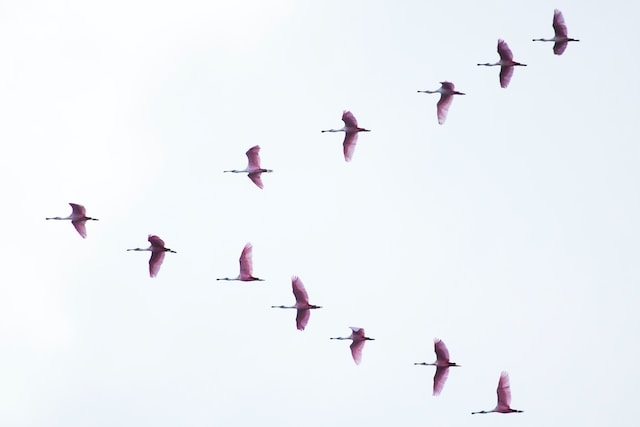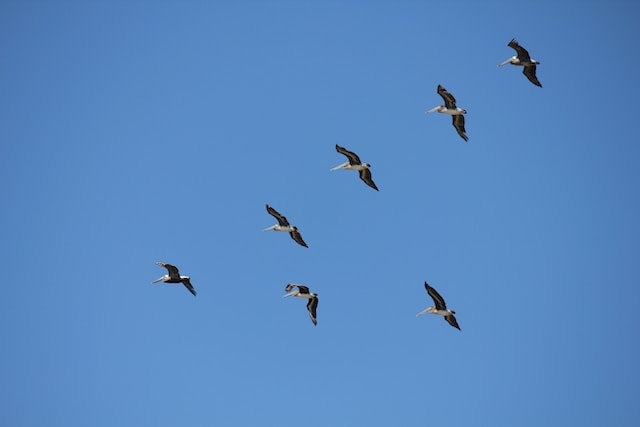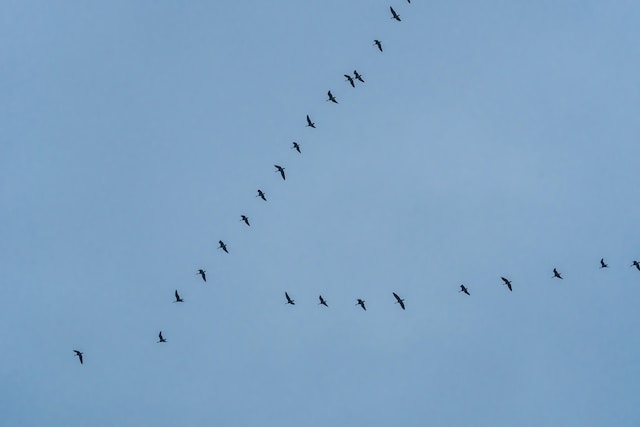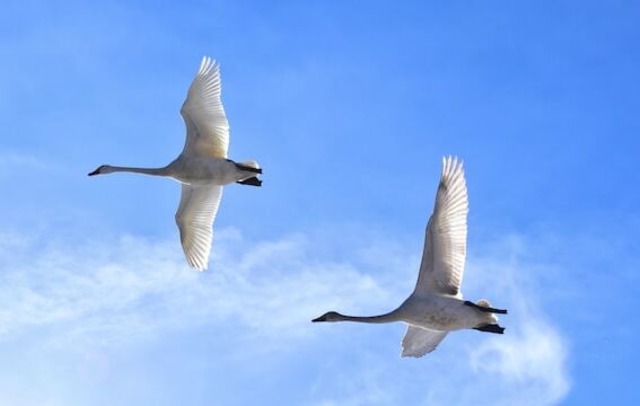Birds are remarkable creatures that have always fascinated me with their unique abilities. One of the most intriguing behaviors observed in birds is their flight in a V-formation. This is a pattern where birds fly in a specific geometric shape, with one bird at the front and the others following behind in two diagonal lines.
This behavior has been observed in several bird species, and it has been the subject of extensive scientific study. Researchers have been fascinated by the reasons behind this behavior and its significance in bird migration strategies.
In this article, I will explore the fascinating world of birds that fly in a V-formation. We will delve into their unique flight patterns, examine the reasons behind this behavior, and uncover the secrets of their remarkable group flight dynamics. We will also explore the scientific explanations behind this behavior and the species that exhibit it.
Table of Contents
- 1 Key Takeaways
- 2 Understanding Avian Social Behavior
- 3 The Significance of Flight Formations
- 4 The Science Behind the V-Formation
- 5 Species that Utilize the V-Formation
- 6 Unraveling the Mysteries of V-Formation Flight
- 7 Natural Spectacle and Human Fascination
- 8 Factors Influencing Formation Shapes
- 9 Conclusion
- 10 FAQs
- 10.1 Why do birds fly in a V-formation?
- 10.2 How do birds communicate while flying in a V-formation?
- 10.3 Which bird species commonly utilize the V-formation?
- 10.4 Do all bird species fly in a V-formation?
- 10.5 How do birds maintain their positions within the V-formation?
- 10.6 Are there any ongoing scientific investigations regarding V-formation flight?
- 10.7 What factors influence the shapes and patterns of bird formations?
- 10.8 Why are humans fascinated by birds flying in a V-formation?
- 11 Author
Key Takeaways
- Birds that fly in a V-formation are a remarkable example of their social behavior and navigational prowess.
- The V-formation flight pattern is significant in avian migration strategies.
- Research has led to insights into the mechanics of V-formation flight and group flight behavior.
- There are specific bird species that fly in a V-formation, each with unique characteristics and habits.
- The fascination with birds that fly in a V-formation continues to inspire exploration and scientific research.

Understanding Avian Social Behavior
As I begin to explore the reasons behind birds that fly in a V-formation, it is essential to understand their social behavior. Birds are highly social creatures, often gathering in flocks and engaging in coordinated flight.
One reason behind bird flocking behavior is safety in numbers. Flocks make it harder for predators to single out individual birds, as they blend in with the group. The coordinated flight patterns of flocks also help birds conserve energy, as the flapping of their wings creates currents of air that other birds can use to their advantage.
Birds also communicate with each other while in flight, using a variety of visual and auditory signals. For instance, when flocks change direction, birds on the outside of the formation will turn towards the inside and vice versa. This helps ensure that flocks maintain their shape and prevent collisions.
Communication in flight is also essential during migration, when birds are traveling long distances. Flocks follow specific navigational cues to reach their destination, such as using the position of the sun or stars, as well as landmarks on the ground.
The Significance of Flight Formations
Flying in formation is a common behavior observed in several bird species. However, the V-formation, in particular, is notable for the advantages it confers on birds during flight.
One key benefit of the V-formation is the reduction of air resistance for all birds except the lead bird. By carefully positioning themselves behind the bird in front of them, the birds in the V-formation can take advantage of the lift generated by the bird ahead of them. This allows them to conserve energy and fly more efficiently, making long-distance migration less taxing.
Another advantage of the V-formation is improved navigation. Birds flying in formation are able to maintain a consistent heading by using their vision to track the position and movements of the birds around them. In addition, birds in the V-formation may use other navigational cues, such as the earth’s magnetic field or the position of the sun, to maintain their direction and make adjustments as necessary.
The effectiveness of the V-formation as a migration strategy is evident in the fact that many bird species utilize this flight pattern during their annual migrations. For example, Canada geese are well-known for their distinctive V-formation flight, which allows them to make long-distance migrations across North America.
Overall, flying in formation is an important aspect of bird migration strategies, and the unique flight dynamics of the V-formation provide birds with significant advantages in terms of energy conservation and navigation. By studying the navigational cues and group flight behavior of birds, scientists continue to gain insights into the remarkable abilities of these fascinating creatures.
The Science Behind the V-Formation
As I mentioned earlier, the V-formation is a significant flight pattern observed in several bird species that migrate long distances. This pattern allows birds to conserve energy and improve their navigational abilities. But how do they do it?
Scientists have extensively studied bird migration patterns and the flight dynamics of V-formation birds to unravel the mysteries behind this behavior. One of the key factors that make V-formation flight possible is the aerodynamic efficiency it offers.
When a bird flies, it creates a wake upwash vortex, which other birds can take advantage of by flying just behind and to the side of the bird in front. This helps reduce the drag and allows them to fly more efficiently.
Another factor that contributes to V-formation flight is the social behavior of birds. By flying in formation, birds can communicate with each other through calls and visual cues, making it easier to coordinate their movements and maintain their positions within the formation.
This behavior improves their navigational abilities, and they can also use other environmental cues, such as the position of the sun and the Earth’s magnetic field, to help them stay on course.
Finally, V-formation flight allows birds to conserve energy by taking turns leading the formation. The bird at the front of the V-formation experiences the most air resistance, while the birds behind it can take advantage of the reduced air resistance and fly more efficiently.
Therefore, birds take turns leading the formation to conserve their energy and maintain their flight for longer periods of time.
Overall, by understanding bird migration patterns and studying the flight dynamics of V-formation birds, scientists have gained valuable insights into the physical and physiological factors that make this flight pattern possible. This knowledge has helped us better appreciate the remarkable abilities of these birds and the significance of their group flight behavior.

Species that Utilize the V-Formation
While the V-formation flight pattern is observed in several bird species, some are more well-known for their utilization of this behavior than others. Waterfowl, such as geese and swans, are commonly seen flying in V-shaped formations during their migratory journeys.
These birds are particularly suited to this flight pattern due to their large size and strong wings. By flying in a V-formation, they are able to conserve energy and reduce drag by taking advantage of the upwash created by the bird in front of them.
Other bird species that utilize the V-formation include pelicans, cranes, and ibises. These birds also benefit from the energy-saving properties of flying in formation and may use this behavior during their migrations or when traveling in groups.
Interestingly, not all bird species have been observed flying in a V-formation. Some birds, such as songbirds and raptors, may fly in loose flocks or individually during migration.
Geese and Swans
Geese and swans are perhaps the most well-known birds that fly in a V-formation. These waterfowl species are often observed during their fall and spring migrations, traveling long distances between breeding and wintering grounds.
When flying in a V-formation, geese and swans are able to maintain communication with each other through honking calls and visual cues. The lead bird in the V-formation sets the pace and direction of flight, with the other birds following closely behind.
The birds take turns flying in the lead position, allowing each bird to conserve energy and reducing the overall fatigue and stress of the long journey.
Pelicans, Cranes, and Ibises
Pelicans, cranes, and ibises are other bird species that have been observed flying in a V-formation. These birds may use this flight pattern during migration or when traveling in groups.
Like geese and swans, these birds benefit from the energy-saving properties of flying in formation. In addition, they may use this behavior as a way to maintain social bonds and communication with each other during flight.
Spoonbills
Spoonbills, with their distinctive spoon-shaped bills, are not commonly associated with V-formation flights, unlike geese and swans. However, there can be exceptions to their flight behavior. Spoonbills are often found foraging in wetland areas, sweeping their unique bills through the water to capture aquatic prey.
In some instances, though rare, observations have been made of spoonbills flying in a V-formation. While this behavior is not typical for them, it can occur under certain circumstances. The reasons behind such behavior and the factors that lead to it are still a subject of interest for ornithologists.
Spoonbills may not use V-formation flights as consistently as geese and swans, but these occasional sightings add to our understanding of the versatility and adaptability of bird behavior in various contexts.
Overall, the V-formation flight pattern is a unique and fascinating behavior observed in several bird species. By working together and taking advantage of each other’s presence, birds are able to make the long and strenuous journey of migration more manageable and less taxing on their bodies.
Unraveling the Mysteries of V-Formation Flight
While scientists have made significant progress in understanding the mechanics of V-formation flight, there is still much to learn about the intricacies of group flight behavior and the evolutionary advantages it provides to migratory birds.
Research has shown that birds in a V-formation can conserve energy by taking advantage of the air currents created by the bird in front of them. The lead bird must work harder, breaking through the air resistance, while the other birds can ride in their slipstream, reducing drag on their wings and saving energy.
Additionally, birds in formation can better navigate by utilizing the visual cues of their fellow flock members. This can be especially helpful when flying at night or in low visibility conditions, as birds can stay on course by keeping their position relative to the birds around them.
Recent studies have also suggested that birds in V-formation may coordinate their movements through a form of non-verbal communication that is not yet fully understood. This communication may involve subtle changes in wing flapping or body positioning that can be detected by other birds in the formation.
Overall, the study of group flight behavior in migratory birds continues to yield fascinating insights into the complexities of avian social behavior and navigational prowess.

Natural Spectacle and Human Fascination
There is no denying the awe-inspiring beauty of watching birds fly in a V-formation. This natural spectacle has captivated human beings for centuries, and it’s not hard to see why. The sight of hundreds or even thousands of birds moving in unison is a testament to the incredible coordination and cooperation that exists in the animal kingdom.
For many, the experience of witnessing birds that fly in a V-formation is a spiritual or emotional one. It’s no wonder that this phenomenon has been celebrated in art, literature, and cultural traditions around the world.
From the ancient Egyptians who associated birds with the soul, to Native Americans who saw them as messengers from the spirit world, birds have long held a special place in our collective consciousness.
But beyond the cultural significance of birds in flight, there is also a scientific fascination with this behavior. The study of bird migration patterns has revealed the incredible distances that some species are able to travel, often crossing entire continents and even oceans to reach their destinations.
The V-formation is just one of the many strategies that birds use to conserve energy during these long journeys, and it has captured the attention of ornithologists and scientists for decades.
As we continue to uncover the mysteries of bird migration and group flight behavior, the fascination with birds that fly in a V-formation is likely to grow. Whether we are inspired by the spiritual significance of this natural spectacle, or drawn in by the scientific intrigue of the behavior, one thing is clear: birds have the power to captivate us in ways that few other animals can.
Factors Influencing Formation Shapes
While the V-formation is the most commonly observed flight formation, there are variations in formation shapes among different bird species. As a bird migration strategy, group flight behavior can be influenced by various factors, such as flock size, wind conditions, and environmental factors.
One of the critical factors in determining the shape of bird formations is flock size. Larger flocks tend to form more extended and more complex flight patterns compared to smaller flocks. This is because larger flocks require more space to fly, and their size makes it possible for them to maintain stability despite the forces of wind and turbulence.
Another factor that can influence the shape of bird formations is wind conditions. Strong winds can alter the direction of flight and cause birds to adjust their formation to maintain optimal flight conditions. For example, in gusty conditions, birds may fly in a tighter V-formation to reduce drag and save energy.
Environmental factors such as terrain, vegetation, and water features can also influence the shape and pattern of bird formations. For instance, birds may shift from a V-formation to a diagonal line or an echelon formation when flying over mountainous terrain or bodies of water.
The shape of bird formations is not only influenced by external factors, but also by the individual flight behavior of each bird in the flock. Recent studies have shown that birds adjust their flight paths in response to the movement of their flockmates, allowing for flexibility and agility in flight.
Understanding the various factors that influence the shape and pattern of bird formations is essential for ornithologists and bird enthusiasts alike. By studying these patterns, we can gain insight into the mechanics and dynamics of group flight behavior, and further unravel the mysteries of avian migration strategies.
Conclusion
Exploring the phenomenon of birds flying in a V-formation has been a fascinating journey. Through examining their avian social behavior, flight formations, and navigational cues, we have gained a deeper understanding of their remarkable group flight dynamics and the significance of this behavior in their migration strategies.
The V-formation flight pattern continues to intrigue and inspire us with its natural spectacle. From the factors that influence formation shapes to ongoing scientific investigations that aim to reveal the mysteries of group flight behavior, this behavior has driven further research in the field of ornithology.
The fascination with birds that fly in a V-formation will never cease to amaze us. As we continue to learn more about their behavior, we gain a newfound appreciation for these magnificent creatures and the incredible abilities they possess. From bird migration patterns and group flight behavior to avian social behavior, bird flocking behavior, bird communication in flight, flying in formation, bird navigational cues, and bird migration strategies, we are reminded that the animal kingdom holds many secrets yet to be uncovered.

FAQs
Why do birds fly in a V-formation?
Birds fly in a V-formation for several reasons. One of the main reasons is that it allows them to conserve energy by taking advantage of the wingtip vortices created by the bird in front. Flying in a V-formation also improves their aerodynamic efficiency and allows for better communication and coordination within the flock.
How do birds communicate while flying in a V-formation?
Birds communicate while flying in a V-formation through a combination of visual cues and vocalizations. They rely on visual signals, such as changes in wing movements and body positions, to maintain their positions within the formation. They also use vocalizations to communicate with each other and coordinate their flight.
Which bird species commonly utilize the V-formation?
The V-formation is commonly observed in several bird species, including geese, ducks, swans, and cranes. These species are known for their long-distance migratory flights and have evolved to take advantage of the benefits provided by flying in a V-formation.
Do all bird species fly in a V-formation?
No, not all bird species fly in a V-formation. While some species have evolved to utilize this flight pattern, others have different flocking and flight behaviors. The V-formation is just one of the many strategies that birds employ during their migrations.
How do birds maintain their positions within the V-formation?
Birds maintain their positions within the V-formation by adjusting their flight speed and wing flapping frequency. They also rely on visual cues from the birds around them, adjusting their positions in response to changes in the formation. This coordination allows the flock to maintain a stable and efficient flight pattern.
Are there any ongoing scientific investigations regarding V-formation flight?
Yes, there are ongoing scientific investigations aimed at further understanding the intricacies of V-formation flight. Researchers are studying the physiological and behavioral aspects of birds in flight to gain insights into how they coordinate their movements and navigate during long migratory journeys.
What factors influence the shapes and patterns of bird formations?
The shapes and patterns of bird formations can be influenced by various factors. Flock size, wind conditions, and environmental factors all play a role in determining the formation shape. Birds adjust their flight patterns in response to these factors to ensure optimal flying conditions within the flock.
Why are humans fascinated by birds flying in a V-formation?
Humans are fascinated by birds flying in a V-formation because it is a visually stunning spectacle that showcases the extraordinary abilities of these creatures. It also symbolizes unity, teamwork, and the beauty of nature, inspiring awe and wonder in those who witness it.



